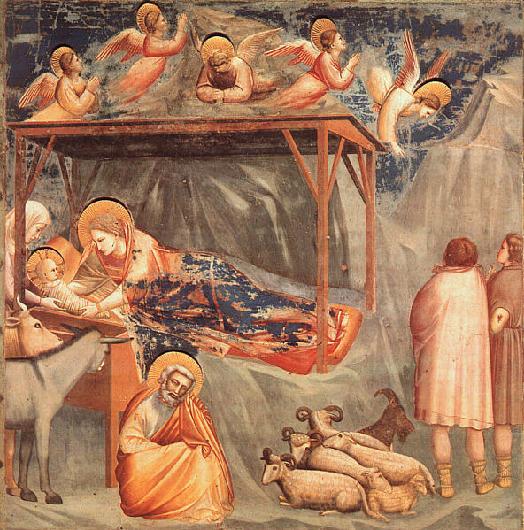|
The Nativity
Rick Darby posts a most unusual painting of the Nativity by Giotto, followed by Chesterton’s thoughts about the unique hold that the story of the birth of Christ has over human nature.
 D. from Seattle writes:
Merry Christmas! (Well at least for the majority of Christians on the Gregorian calendar—for those of us on the Julian calendar it’s still 13 days away.)LA replies:
First, the orange-y color was striking and seemed unusual. Second, the layout, which suggested, not the usual manger (a stable in a barn), but something more like a rock-dug basement or cave with different levels (which by the way corresponds with what some historians think the birth place would have been like, as stables in Judea of that time were commonly in long, cave-like basements underneath the house of the owner). Third, the three-leveled, hierarchical arrangement within this cave, with the shepherds and the sheep and other animals on the lowest level, then Mary and the baby in a kind of wooden structure suspended in mid air or cantilevered out from the rock wall, and then at the highest level the angels, suggesting how the angels in heaven are rejoicing at the birth of Christ.December 25 George R. writes:
I love the Giotto painting. I like also your comments on it.LA replies:
I wasn’t sure if that older man was Joseph or not. That of course is a tradition, to show Joseph as old, to downplay the idea of a marital relationship between Joseph and Mary. There are many other paintings that have a young and vigorous Joseph.December 26 D. from Seattle writes:
Regarding the composition, I believe I didn’t find it unusual due to my Eastern Orthodox background. In traditional Orthodox iconography it is common to depict various characters at various levels and even in various sizes on the same painting based on their importance or closeness to God; meaning Christ, Mother of God and other Saints could be shown larger and above other characters, while less important or negative characters could be shown shrunken and towards the bottom. This is just my observation, of course, not a rigorous study. Wikipedia provides a brief intro into Eastern Orthodox icons here.LA writes:
On Christmas Day at 10:05 a.m, Michelle Malkin as her Christmas greeting posted the same Giotto painting that I saw at Rick Darby’s Reflecting Light on December 24 and copied at VFR. It’s unlikely that Malkin reads this site or Darby’s. What could explain the coincidence? Perhaps the picture was posted at some other site that Malkin and Darby both read. Posted by Lawrence Auster at December 24, 2009 02:26 PM | Send Email entry |